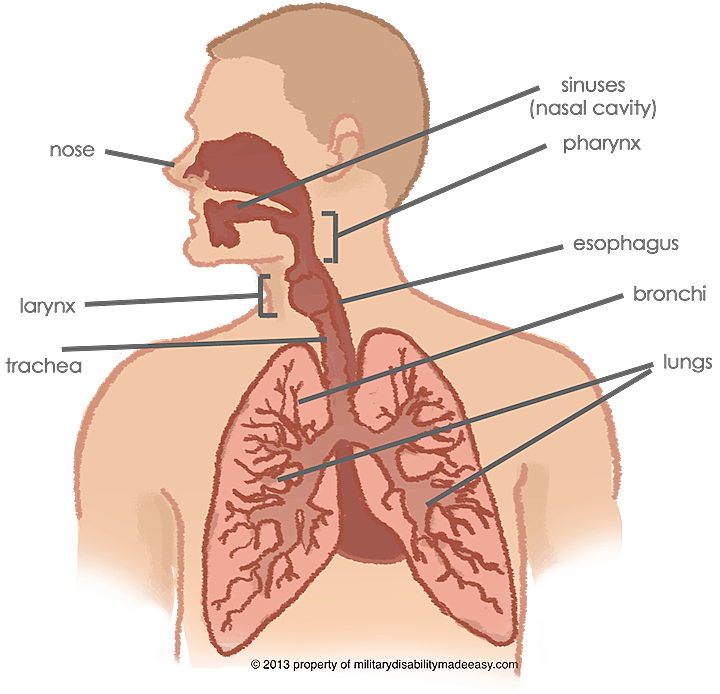The Respiratory System
Topics:
The Respiratory System Overview
Respiratory System Condition Ratings
The Respiratory System Overview
The VA awards disability compensation for each Respiratory System condition that is service-connected. The DoD will also rate service-connected conditions as long as they also make the service member Unfit for Duty. For Reservists, the condition must have occurred in or resulted from an injury in the Line of Duty to qualify.

The Respiratory System consists of everything responsible for bringing air into and out of the lungs, absorbing oxygen into the blood, and exhaling carbon dioxide. It includes the nose, sinuses, pharynx, larynx, trachea, lungs, and bronchi (bronchial trees).
The VASRD offers rating options for Respiratory System conditions based on how well air is pulled into the lungs, oxygen is absorbed into the blood, and the remaining air exhaled from the lungs. There is a range of pulmonary function tests (PFTs) that are essential to properly rating most Respiratory System conditions, including spirometry, diffusion capacity, and exercise testing. See the Respiratory System Ratings page for full details on the necessary tests required to properly rate Respiratory System conditions.
To honor the Pyramiding Principle, only a single rating can be given for multiple Respiratory System conditions since it is practically impossible to separate the symptoms. In most cases, multiple Respiratory System conditions will be rated using all of the symptoms combined together, and the VA will choose the single code they feel best covers the overall Respiratory System disability (see The Respiratory System Ratings page for details and any exceptions).
Return to Top
Respiratory System Condition Ratings
The VASRD offers ratings for the following conditions of the Respiratory System:
- Conditions of the Nose and Sinuses
- Conditions of the Throat
- Restrictive Lung Conditions
- Obstructive Lung Conditions
- Interstitial Lung Diseases
- Pulmonary Vascular Diseases
- Fungal Infections of the Lungs
- Bacterial Infections of the Lungs
- Sleep Apnea
- Tuberculosis of the Respiratory System
- Cancer and Tumors of the Respiratory System
If a condition is not directly listed on The Respiratory System Ratings page, it is rated under the code that best describes it or its dominant symptoms.
Return to Top
FAQs
How will the VA rate my Respiratory conditions?
The VA uses the rules of the VASRD to rate Respiratory conditions based on how they limit the ability to breath. Check out our Respiratory System Ratings page for the exact codes and ratings.
My Respiratory condition wasn't diagnosed until after I was discharged. Can it qualify for VA disability?
The VA can only rate conditions that meet some type of service-connection requirement. For conditions diagnosed after service, the condition must either be a secondary condition caused by another service-connected condition, or it must be on the VA's Presumptive List.
Are my conditions eligible for a rating?
Your conditions are eligible to be rated by the VA if they are the result of your military service. You must be able to show proof of service-connection for each condition. For the DoD, they will rate your service-connected conditions as long as they also make you Unfit for Duty.
How do I apply to receive my ratings?
If you are still in the military, then you can request your military physician to refer you to the MEB and start the IDES process. If you are already a veteran, you can submit a VA Disability Claim along with evidence of service-connection and all medical records regarding the conditions on the claim.
If my claim is approved, what benefits will I receive?
If you are rated 20% or less from the DoD, then you will receive a single separation payment. If you are rated 30% or more, you will receive full retirement benefits. From the VA, you will receive a monthly payment as well as full medical care from the VA for the qualifying conditions.
How long does it take to receive my disability benefits?
Brand new claims usually take 3-6 months to process. Once processed, you will start receiving payments in 1-3 months.
How are the rating percentages assigned to my conditions?
The rules of the VA's Schedule for Rating Disabilities (VASRD) are used to assign rating percentages to conditions. The VASRD gives rating rules for conditions based on their symptoms, treatment options, and the resulting level of disability they cause.
My conditions have worsened. How do I increase my rating percentages?
If your conditions have worsened since you last applied and now qualify for a higher rating, you can submit a new claim, checking the box for an increased evaluation.


